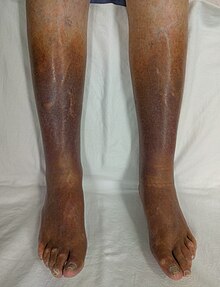| Venous stasis | |
|---|---|
| Other names | Venostasis |
 | |
| Skin changes as a result of long term venous stasis | |
Venous stasis, or venostasis, is a condition of slow blood flow in the veins, usually of the legs.
Presentation
Complications
Potential complications of venous stasis are:
- Venous ulcers
- Blood clot formation in veins (venous thrombosis), that can occur in the deep veins of the legs (deep vein thrombosis, DVT) or in the superficial veins
- Id reactions
Causes
Causes of venous stasis include:
- Obesity
- Pregnancy
- Previous damage to leg
- Blood clot
- Smoking
- Swelling and inflammation of a vein close to the skin
- Congestive heart failure.
- Long periods of immobility that can be encountered from driving, flying, bed rest/hospitalization, or having an orthopedic cast. Recommendations by clinicians to reduce venous stasis and DVT/PE often encourage increasing walking, calf exercises, and intermittent pneumatic compression when possible.
- Weakened Venous valves: these are crucial towards ensuring upward flow to the heart from the lower extremities. If weakened, they may fail to close properly which leads to backwards blood flow/blood pooling. This can lead to slower blood flow in the veins.
Ultrasonography-Doppler ultrasound
See also
References
- Ferree, S. D.; Yang, C.; Kourosh, A. S. (2019-04-20). "Autosensitization dermatitis: A case of rosacea-like id reaction". JAAD Case Reports. 5 (5): 410–412. doi:10.1016/j.jdcr.2019.02.029. PMC 6479112. PMID 31049383.
- "Chronic Venous Insufficiency". www.hopkinsmedicine.org. 2021-08-08. Retrieved 2022-11-17.
- Zhu, Ruiqi; Hu, Yu; Tang, Liang (2017). "Reduced cardiac function and risk of venous thromboembolism in Asian countries". Thrombosis Journal. 15 (1): 12. doi:10.1186/s12959-017-0135-3. ISSN 1477-9560. PMC 5404284. PMID 28450810.
- Barbara G. Wells; Joseph T. DiPiro; Terry L. Schwinghammer; Gary R. Matzke; Gary C. Yee; Robert L. Talbert; L. Michael Posey (2008). Pharmacotherapy Handbook. McGraw-Hill Professional. p. 163. ISBN 9780071485012.
- "New DVT guidelines: no evidence to support "economy class syndrome"; oral contraceptives, sitting in a window seat, advanced age, and pregnancy increase DVT risk in long-distance travelers". American College of Chest Physicians. 7 February 2012. Archived from the original on 18 October 2013. Retrieved 10 February 2012.
- Hecht, M. E. (2010). A practical guide to hip surgery: from pre-op to recovery. Sunrise River Press. ISBN 978-1-934716-12-0.
- Gould MK, Garcia DA, Wren SM, et al. (2012). "Prevention of VTE in nonorthopedic surgical patients: antithrombotic therapy and prevention of thrombosis, 9th ed: American College of Chest Physicians evidence-based clinical practice guidelines". Chest. 141 (suppl 2): e227S–e277S. doi:10.1378/chest.11-2297. PMC 3278061. PMID 22315263.
- Whiteley MS (2011). "Understanding Venous Reflux - the cause of varicose veins and venous leg ulcers". Whiteley Publishing. Archived from the original on October 25, 2017. Retrieved January 8, 2015.